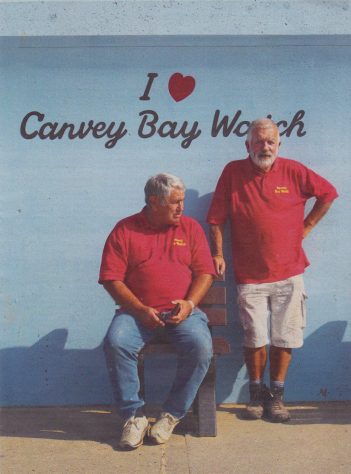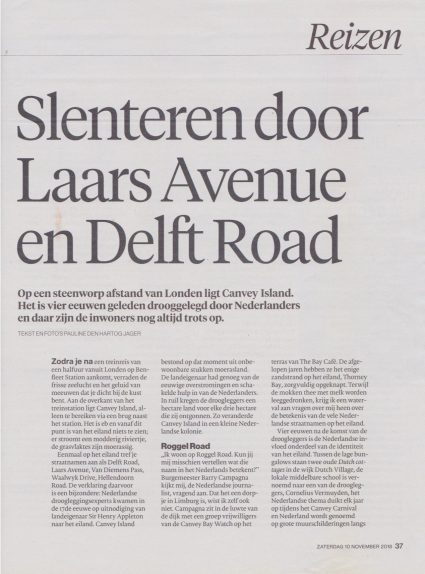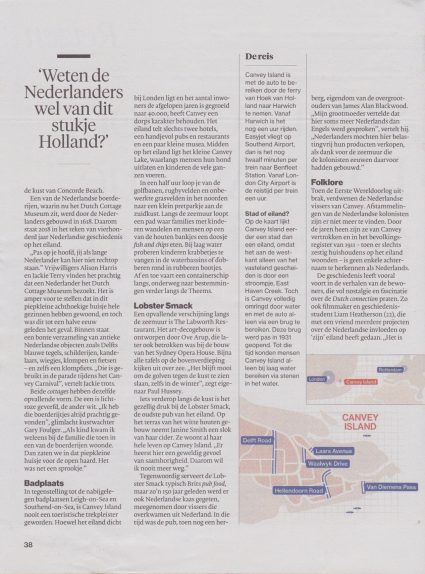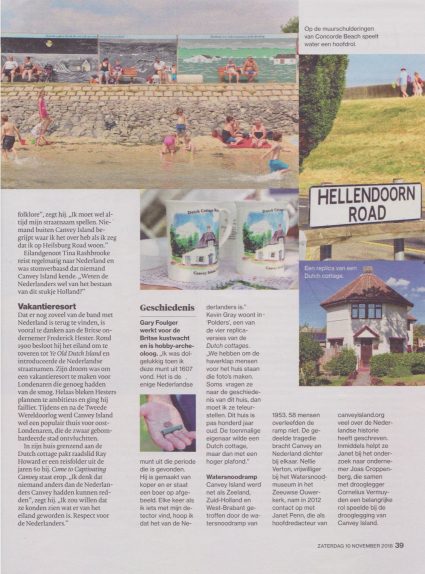 After Pauline den Hartog’s visit in the summer her article about Canvey Island has now been published. It is not only in the National newspaper but also the regional ones.
After Pauline den Hartog’s visit in the summer her article about Canvey Island has now been published. It is not only in the National newspaper but also the regional ones.
Unfortunately the text is not clear in these photos but as it is in Dutch you won’t understand it anyway.
Bay Watch has taken centre stage. But thankfully they did not use my photo. 🙂
With grateful thanks to Nellie Verton for sending us the photos. Also to Agnes van Lowlands and Janet Roodbol-Birkin for the translations.
Canvey Island: A stroll through Laars Avenue and Delft Road
 Not far from London lies Canvey Island. It was drained by the Dutch four centuries ago and the current inhabitants are still proud of that.
Not far from London lies Canvey Island. It was drained by the Dutch four centuries ago and the current inhabitants are still proud of that.
As soon as you arrive at Benfleet Station after a half-hour train journey from London, the fresh sea air and the sound of gulls tell you are close to the coast. On the other side of the train station is Canvey Island, accessible only via a bridge. It is low tide and from this point onward nothing indicates it is an island; a muddy channel barely flows, the grassy pastures are just swampy.
Once on the island you will find street names such as Delft Road, Laars Avenue, Van Diemens Pass, Waalwyk Drive, Hellendoorn Road. The explanation for this is a special one; Dutch drainage experts came here in the 17th century at the invitation of landowner Sir Henry Appleton. Canvey Island at that time consisted of uninhabitable areas of marshland. The landowner had enough of the constant floods and turned to the Dutch for help. In return, they received one hectare of land for every three hectares they reclaimed. This transformed Canvey Island into a small Dutch colony.
Roggel Road
“I live on Roggel Road. Can you tell me what that name means in Dutch?” Mayor Barry Campagna looks at me, the Dutch journalist, inquiringly. No, I didn’t know that it meant a village in Limburg either. Campagna sits in the shelter of the dike with a group of volunteers from the Canvey Bay Watch on the terrace of The Bay Café. In recent years they have carefully restored the sandy beach on the island, Thorney Bay. While the mugs of tea with milk are being emptied, I get questioned about the meaning of the many Dutch street names on the island.
Four centuries after the arrival of the drainage experts, the Dutch influence is still part of island’s identity. Between the low bungalows there are two old Dutch cottages in the Dutch Village area, one of the two secondary schools is named after Cornelius Vermuyden, the Dutch theme pops up every year during the Canvey Carnival and the Netherlands is mentioned on large murals which adorn the seawall along Concord Beach.
One of the Dutch houses, in which the Dutch Cottage Museum is now located, was built by the Hollanders in 1618. That is why 2018 is dominated by four hundred years of Dutch history on Canvey.
“Be careful, you as a tall Dutch cannot stand up here!” Volunteers Alison Harris and Jackie Terry are delighted that a Dutchwoman is visiting the Dutch Cottage.
It is hard to imagine that entire families lived in this tiny octagonal dwelling, and yet this was the case up to half a century ago. Inside, there is a colourful collection of old Dutch objects such as Delft blue tiles, paintings, candlesticks, cradles, clogs and bicycles; and even a clog bike. “It’s been used in the parade during the Canvey Carnival”, says Jackie proudly.
Both cottages have the same striking shape. One is dyed light pink, the other white,”I’ve always loved those cottages” smiles Coast Guard Gary Foulger. “As a child I sometimes came to the family who lived in one of them. Then we sat in that tiny house in front of the fireplace. It was like a fairy tale.”
Seaside resort
 Unlike the nearby seaside resorts of Leigh-on-Sea and Southend-on-Sea, Canvey Island has never become a main tourist attraction. Although this island is close to London and the number of inhabitants has grown to 40,000 in recent years, Canvey has retained a village character. The island has only two hotels, a handful of pubs and restaurants and a few small museums. In the middle of the island lies Canvey Lake, where people walk their dogs and children feed the geese.
Unlike the nearby seaside resorts of Leigh-on-Sea and Southend-on-Sea, Canvey Island has never become a main tourist attraction. Although this island is close to London and the number of inhabitants has grown to 40,000 in recent years, Canvey has retained a village character. The island has only two hotels, a handful of pubs and restaurants and a few small museums. In the middle of the island lies Canvey Lake, where people walk their dogs and children feed the geese.
In just half an hour you can walk from the golf course, rugby pitches and wild grass fields on the north side to a small amusement park on the south part of this island. There is a path along the sea wall where families with children can have a stroll and people can enjoy their fish and chips on one of the wooden benches. At low tide children try to catch crabs in the water basins or float around in rubber boats. Occasionally a container ship sails past to destinations along the Thames.
Lobster Smack
The Labworth Restaurant has a striking appearance along the sea wall. The Art Deco building was designed by Ove Arup, who was later also involved in the construction of the Sydney Opera House. Almost all tables on the upper floor look out over the sea. “It is nice to see the waves hitting the shore, even in the winter,” says owner Paul Hussey.
A little further along the shore it is pleasantly busy at the Lobster Smack, the oldest pub on the island. On the terrace of the white wooden building Janine Smith takes a sip of her cider. She has lived on Canvey Island all her life. “There is a great feeling of community here. That’s why I don’t ever want to leave.”
Nowadays the Lobster Smack serves typically British pub food, but about 150 years ago Dutch cheese was also eaten; it was brought by fishermen who came from the Netherlands. At that time the pub, then still an Inn, was owned by the great-grandparents of James Alan Blackwood.“ My grandmother said that sometimes more Dutch than English was spoken here,” he says. “Dutch people were allowed to sell their products tax-free here, as a thank you for the sea wall that the settlers had built centuries before.”
Folklore
When the First World War broke out, the Dutch fishermen from Canvey disappeared. Descendants of the Dutch settlers are no longer to be found. Over the years they have left Canvey and in the population register of 1911 – when only 60 households lived on the island – no surname can be recognised as Dutch.
History mainly lives on in the stories of the residents, who speak with nostalgia and fascination about the Dutch connection. Also filmmaker and history student Liam Heatherson (22), who has done several projects with a friend about the Dutch influences on ‘his’ island. “It’s folklore,” he says. “I always have to spell my street name. No one outside of Canvey Island understands what I’m talking about when I say that I live on Heilsburg Road.”
Fellow islander, Tina Rashbrooke who regularly travels to the Netherlands was stunned that no one there knew of Canvey Island. “Do the Dutch know about the existence of this little piece of Holland?”
Holiday resort
The fact that this bond with the Netherlands can still be found is mainly due to the British entrepreneur Frederick Hester. Around 1900 he decided to turn the island into Ye Old Dutch Island and introduced the Dutch street names. His dream was to create a holiday resort for Londoners who had had enough of the city smog. Unfortunately, Hester’s plans proved too ambitious and he went bankrupt. During and after the Second World War, Canvey Island became a popular home for East Londoners, who fled the heavily bombed city.
In his house adjoining the Dutch cottage, council member Ray Howard takes a travel brochure from the 1960s. “Come to Captivating Canvey” it says on it. “I think that no one other than the Dutch could have saved Canvey,” he says. “I wish they could see what has become of the island. Respect for the Dutch.”
The journey
Canvey Island can be reached by car by taking the ferry from Hoek van Holland to Harwich. From Harwich it is still an hour drive. Easyjet flies to Southend Airport, then it is another twelve minutes by train to Benfleet Station. From London City Airport the journey by train takes one hour.
Town or island?
On the map, Canvey Island seems to be a town rather than an island, because on the west side it is only separated from the mainland by a little creek, namely East Haven Creek. Yet Canvey is completely surrounded by water and can only be reached by car via bridges. The first bridge was only opened in 1931. Until then, people could only reach Canvey Island at low tide via stepping stones in the water.
 History
History
Gary Foulger works for the British coastguard. Archeology is his hobby. “I was thrilled when I found this coin dating from 1607. It is the only Dutch coin ever found from that period. It is made of copper and shows a farmer. Every time I find anything with my metal detector, I hope it will be Dutch.”
Kevin Gray lives in ‘Polders’, one of the four replicas of the Dutch cottages. “We frequently see people standing in front of the house, taking photographs. They sometimes ask about the history of this house, but I have to disappoint them. This house is only 100 years old. The owner at that time wanted a Dutch cottage, but with higher ceilings.”
The flood disaster
Just like the Dutch provinces of Zeeland, Zuid-Holland and West-Brabant, Canvey Island was hit by the great flood of 1953. 58 lives were lost. This shared tragedy brought Canvey and the Netherlands closer together. In 2012 Nellie Verton, volunteer at the Watersnoodmuseum (Flood Museum) in Ouwerkerk, Zeeland, contacted Janet Penn, who as chief editor of the website canveyisland.org has written a great deal about the Dutch history. Nellie is now helping Janet with her research into the entrepreneur Joas Croppenberg, who along with drainage expert Cornelius Vermuyden played a major part in draining Canvey Island.




No Comments
Add a comment about this page